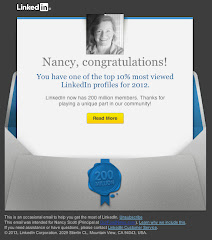by *Jason Wells
• 91% of all U.S. citizens have their mobile phones within arms-reach 24/7 – Source: Morgan Stanley, 2011.
• It takes 90 minutes for the average person to respond to an email. It takes 90 seconds for the average person to respond to a text message – Source: CTIA.org, 2011.
• There are roughly 7 billion people on the planet. 5.1 billion own a mobile phone. 4.2 billion own a toothbrush – Source: Mobile Marketing Association Asia, 2011.
• 7 out of 10 mobile searchers take action within one hour – Source: Mobile Marketer, 2011.
• Mobile Internet usage will surpass desktop Internet usage by 2013 or 2014 - Source: Google, 2012.
• 90% of mobile searches lead to action, over half leading to purchase - Source: Google
• 70% of mobile searches lead to action within one hour. 70% of online searches lead to action within one month - Source: Mobile Marketer, 2011.
And because of these fairly
mind-blowing statistics, many in the traditional marketing world—especially
direct mail—are, frankly, feeling some fear. We talk to direct mail firms, publishers, and even online marketers that
feel some serious trepidation about the vast unknown universe of mobile
marketing.
But, our message is simple: Rather than being afraid of mobile, traditional marketers should view mobile as
an opportunity, not a challenge. Traditional direct marketers are uniquely
positioned to succeed at mobile. Why? Here are some reasons:
1. Same Concepts – Traditional direct marketers understand the
basic concepts of mobile marketing. Think about it. Mobile marketing
demands—and often produces—an actual response. Its primary purpose isn’t
branding or public relations. Sound familiar?
Direct marketers who know nothing
about mobile marketing already know more about it than they think. Direct
marketers ‘get’ mobile. It is marketers that are concerned with branding,
public relations or merely driving web traffic that ought to be concerned.
Direct marketers, on the other hand, already understand how mobile works.
2. Targeted Focus – Mobile works because it is hyper-targeted,
location-based, focused on reaching the correct group of people. Mobile
succeeds because it can focus on people most likely to buy and then measure
results. Sound familiar?
3. Same Goals - The goal of a mobile marketing campaign is a phone
call or a text message—in other words, a response. Similarly the goal of any
direct marketing campaign is a response.
4. Vast Opportunity for Integration – Because there is so much
commonality between traditional direct marketing and mobile marketing, there is
a great opportunity for integration. Direct mail firms, for example, could set
up automated textback to mobile callers, thanking them for calling, or even
giving them a specific mobile offer. (Imagine being able to offer something
like that to clients).
Online marketers should create a
mobile website and optimize their landing pages for mobile search. (And, if you
did this you’d be at the forefront of innovation. Google says that 79% of
marketers still don’t have a mobile site of any kind). And if your not ready to
go totally mobile, you can test mobile microsites and landing pages for
specific campaigns as an alternative to rolling out a full mobile site.
Don’t Fear the Mobile Beast
My point here is simple: Of all
the people in the marketing world, direct marketers have the most to gain from
the mobile marketing explosion. You share the same concepts as mobile. You
share the same goals. You share the same desire to measure and demonstrate
success and to target focused and highly selected groups.
So, even though mobile is a
beast, view it as a friendly beast. A beast you can tame if you are prepared.
*Jason Wells is the CEO of ContactPoint. Their new product, LogMyCalls,
represents the next generation of intelligent
call tracking and marketing automation. Prior to joining ContactPoint, Jason
served as the Senior Vice President of Sony International, where he led the
creation and international expansion of Sony’s mobile business line from
London. Jason has spoken on marketing topics at SES New York, SES
Toronto, Ad Tech, Digital Hollywood, Nokia World, CTIA and elsewhere. He holds
an MBA from the Wharton School at the University of Pennsylvania. To read Jason’s work please add LogMyCalls
to your Google+ circles and follow them on Twitter.










